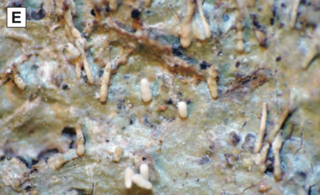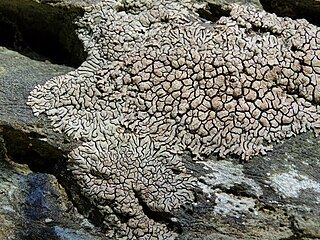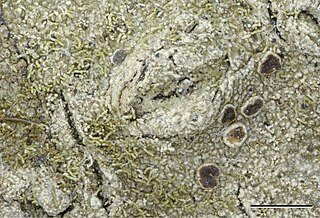
The Graphidaceae are a family of lichen-forming fungi in the order Graphidales. The family contains nearly a hundred genera and more than 2000 species. Although the family has a cosmopolitan distribution, most Graphidaceae species occur in tropical regions, and typically grow on bark.

Acanthotrema is a genus of lichens in the family Graphidaceae. The genus was circumscribed by German lichenologist Andreas Frisch in 2006, with Acanthotrema brasilianum assigned as the type species. Acanthotrema species are commonly found in rainforests ranging from lowland to montane environments.

Roccella is a genus of 23 species of lichens in the family Roccellaceae. The genus was circumscribed by Swiss botanist Augustin Pyramus de Candolle in 1805, with Roccella fuciformis as the type species.

Placopyrenium is a genus of saxicolous (rock-dwelling), crustose lichens in the family Verrucariaceae.

The Trypetheliaceae are a family of mainly lichen-forming fungi in the order Trypetheliales. The family consists almost exclusively of corticolous (bark-dwelling), crustose lichens with an almost strictly tropical distribution.
Punctonora is a genus of lichen-forming fungi in the family Lecanoraceae. The genus was circumscribed in 1997 by lichenologist André Aptroot, with Punctonora nigropulvinata assigned as the type species. A second species was added to the genus in 2018.
Traponora is a genus of lichen-forming fungi in the family Lecanoraceae. The genus was circumscribed in 2009 by Dutch lichenologist André Aptroot, with the Papua New Guinean Traponora asterella assigned as the type, and at that time, only species. Four newly described species were added to the genus in a 2009 publication, a species formerly in Pyrrhospora was transferred to the genus in 2017, and a new species from Australia added in 2018. Traponora lichens are predominantly from Australasia, with all species but one known to occur in Papua New Guinea.

Architrypethelium is a genus of lichen-forming fungi in the family Trypetheliaceae.
Ampliotrema is a genus of lichen-forming fungi in the family Graphidaceae. The genus was originally described invalidly in 2004, and validly two years later.

Neoprotoparmelia is a genus of crustose lichens that was created in 2018. It contains 24 tropical and subtropical species that mostly grow on bark. Neoprotoparmelia is in the subfamily Protoparmelioideae of the family Parmeliaceae, along with the morphologically similar genera Protoparmelia and Maronina.

Coenogonium is a genus of filamentous lichens in the monotypic family Coenogoniaceae. It has about 90 species. Most species are leaf-dwelling or grow on bark, although a few are known to grow on rocks under certain conditions, and some are restricted to growth on termite nests. The genus was circumscribed in 1820 by German naturalist Christian Gottfried Ehrenberg.
Henricus (Harrie) Johannes Maria Sipman is a Dutch lichenologist. He specialises in tropical and subtropical lichens, and has authored or co-authored more than 250 scientific publications. He was the curator of the lichen herbarium at the Berlin Botanical Garden and Botanical Museum from 1983 until his retirement in 2010.
Celotheliaceae is a family of fungi in the monotypic order Phaeomoniellales. It contains 27 species of crustose lichens with thalli that are more or less immersed in tree bark.
Architrypethelium hyalinum is a species of corticolous (bark-dwelling), crustose lichen in the family Trypetheliaceae. Found in Costa Rica and Brazil, it was formally described as a new species in 2008 by lichenologist André Aptroot. The type specimen was collected by Harrie Sipman from the Las Cruces Biological Station in Puntarenas. The lichen has a smooth to uneven, olive-green thallus. Its ascomata occur solitarily, have an apical ostiole, and measure 0.7–1.5 mm in diameter. Ascospores number 4 to 8 per ascus, have an oblong to ellipsoid shape with 3 septa, and measure 100–150 by 30–50 μm. These spores are among the largest of the 3-septate lichens in the Trypetheliaceae. Both the thallus and ascomata contain lichexanthone, a lichen product that causes these structures to glow yellow when lit with a long-wavelength UV light; A. hyalinum is the only species in genus Architrypethelium that contains lichexanthone.
Schistophoron aurantiacum is a species of corticolous (bark-dwelling) lichen in the family Graphidaceae. Found in Costa Rica, it was formally described as a new species in 2007 by lichenologists André Aptroot and Harrie Sipman. The type specimen was collected by the second author from Carara National Park, where it was found along a stream in a partly disturbed primary forest dominated by an understory of the shrub Erythrochiton gymnanthus.
Clandestinotrema is a genus of lichen-forming fungi in the family Graphidaceae. It has 17 species. They typically inhabit montane and cloud forest at higher elevations in the tropics.

Fulvophyton is a genus of lichen-forming fungi in the family Roccellographaceae. It has 11 species. Fulvophyton is characterised by its crust-like thallus, which is often pale yellowish-brown in colour. This genus features a photobiont from the green algal genus Trentepohlia and exhibits a unique arrangement of reproductive structures.
Macroconstrictolumina is a genus of lichen-forming fungi in the family Trypetheliaceae. It has four species.
Enterographa aldabrensis is a species of corticolous (bark-dwelling), crustose lichen in the family Roccellaceae. It is only known to occur in Aldabra in the Seychelles.
Herpothallon fertile is a species of corticolous (bark-dwelling), crustose lichen in the family Arthoniaceae. Originally described from specimens collected in Costa Rica, it was formally described as new to science in 2009 by the lichenologists André Aptroot and Robert Lücking. It also occurs in Brazil, and is considered by the authors to have a wide distribution in "tropical parts of America". Its species epithet fertile reflects the fact that it is the only species of Herpothallon to have been found with asci and ascospores.








